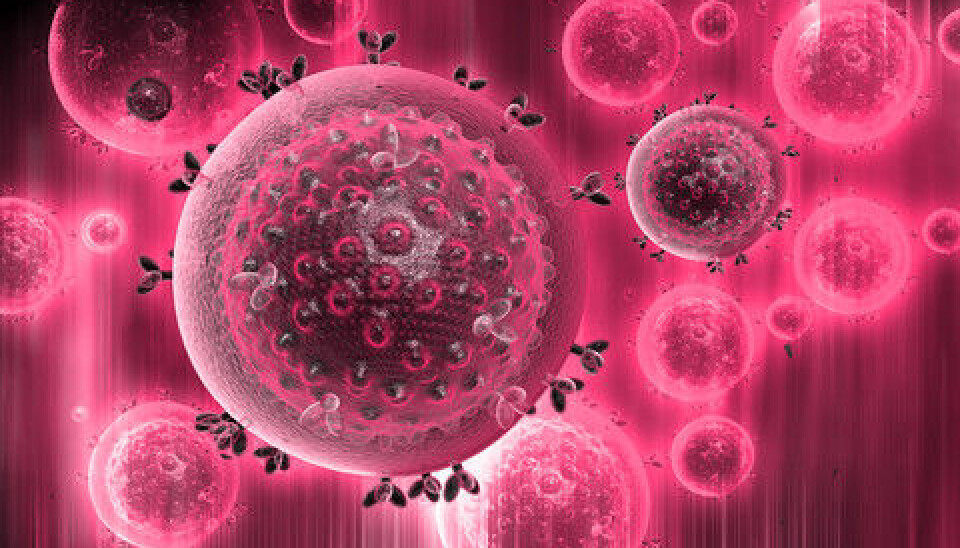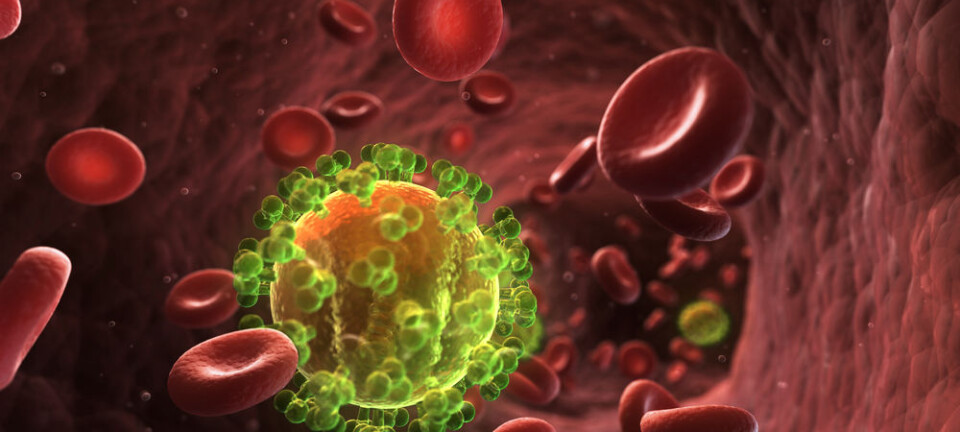An article from University of Oslo

Gene defect that protects against HIV
Not everyone can be infected by HIV. If you have a gene defect, you may be protected.
Denne artikkelen er over ti år gammel og kan inneholde utdatert informasjon.
A HIV virus needs two entry points to penetrate the body. If one route is blocked, the virus cannot penetrate. Using gene manipulation, a method to destroy the HIV virus may become a reality because one entry point will be closed.
The good defect
Professor Dag Kvale at the Institute of Clinical Medicine conducts research into HIV.
“How HIV is transmitted has long been a mystery,” he says.
For a long time researchers believed that the explanation was that the virus binds to a particular cell type which has the CD4 receptor. But the explanation is not as simple as that. In fact not everyone can be infected by HIV.

It is true that the HIV virus does bind to the CD4 receptor in the cells. These receptors are the generals of our immune system and coordinate all our immune responses in the case of external attack. They were discovered to be the point of attack for the HIV virus as early as 1984.
It was not until ten years later that researchers understood that the virus needs an additional receptor to penetrate a CD4 target cell, thus infecting it. If this target cell does not function, you will not be infected by HIV.
Defective gene prevents the disease
Some people have a gene defect in the co-receptor for HIV and live a completely normal life. This gene defect is probably most common among people living in Northern Europe.
“Just like the Norwegian army manages perfectly well even though a little handgun goes missing, the body manages without the CCR5 receptor,” explains Kvale.
Paradoxically, the defective gene does not make you ill, but prevents you from contracting HIV.
Since the CCR5 gene is non-functional, the HIV virus cannot bind itself to it. And it is perhaps here that the key to overcoming the virus lies hidden. By genetically manipulating this gene in HIV patients and making it defective, researchers can perhaps eradicate the virus.
“We have two copies of every gene,” says Kvale, and continues, “People with defects in the co-receptors in both genes do not become infected by HIV. Those who have one healthy and one defective gene are infected more slowly and contract a HIV infection that develops far less rapidly.
The virus that disappeared
The goal is to find a cure for HIV. And this is no longer a Utopian dream, according to Kvale.
One possible path is by genetically manipulating the stem cells in the bone marrow of a HIV-positive person so that they acquire the gene defect that gives protection against HIV.
The case of “The Berlin patient” is unique in HIV research. This relates to a HIV patient who actually got rid of the infection. The patient was HIV positive, and was also stricken by leukemia. As part of his cancer treatment, he underwent a bone marrow transplantation. After being treated with large doses of cytostatic drugs and radiation to kill the cancer cells, he received bone marrow transplanted from a healthy donor.
The donor belonged to the small percentage of people who possess the above-mentioned co-receptor with a defective CCR5 gene. The healthy bone marrow with the defective gene was transplanted into the patient, and the doctors stopped giving him HIV medication. And the result? The HIV virus disappeared.
The intestine’s secret
Even though today’s medicines keep HIV infections in check, there is nevertheless an over-frequency of certain inflammatory diseases among HIV patients.
“On average, patients suffer more frequently from cardiovascular problems, metabolic syndrome, diabetes, high blood pressure and osteoporosis than others do, and we don’t understand why,” says Kvale.
The answer is probably concealed in the intestine, the body’s largest immune organ. Our ten-metre long intestinal tube conceals a massive number of immune cells. During the first weeks after the HIV infection is contracted, enormous numbers of CD4 cells are destroyed in the intestine.
“Until recent years we weren’t aware of this extensive destruction of CD4 cells that takes place at an early stage,” Kvale tells us.
A leaking intestine exhausts the immune system
This loss affects the remainder of the course of the disease in a number of patients. The thin layer of cells between the intestinal content and the body becomes more prone to leakage. Therefore many patients experience that substances that promote inflammation leak in.
Researchers know that some bacterial elements are very potent in this respect. The chronic leakage intensifies the inflammation in the blood vessels, which in turn accelerates arteriosclerosis. In addition, the immune system becomes exhausted. The same bacterial elements alert the immune apparatus, just like the constant ringing of a fire alarm.
“The immune system isn’t a long-distance runner – it’s built for sprinting. The activation of alarms because of leakage from the intestine exhausts the immune system. This contributes substantially to the development of immune system failure in the case of HIV infection,” explains Kvale.
Greater knowledge about these mechanisms means that in the course of time perhaps new forms of treatment can be offered to patients with considerable leakage from the intestine – treatment that may prove favourable in the long term.
Repeal of the death sentence
But let’s go back 30 years in time. Before these medicines. Before treatment. Before hope. Being infected by the HIV virus then was the same as receiving a long-drawn-out death sentence.
At that time there was little knowledge and great fear. Researchers painted a black picture of the situation back then. Some epidemiologists feared a sky-high infection rate – an epidemiological nightmare in which more than 20 per cent of the population would become HIV positive.
A HIV-positive person had barely ten years to live before the body succumbed. Today the situation in our part of the world is totally different. This is due to meticulous work behind the microscope and in the laboratory.
Up to 1996 most of those infected had no chance against the HIV virus. Then along came a treatment that worked. Not a miracle cure that killed the virus, but one that prevented it from replicating itself and infecting new cells. And we are gaining control. Medication also helps to ensure that those who are HIV positive do not transmit the virus to others as long as they are being treated effectively.
The most important test
There has been a huge development in HIV research. Medication controls the virus and stops its transmission. Today the effectiveness of treatment is about 97 per cent, which is among the best in the world.
Unfortunately the situation is not the same in poorer parts of the world. There HIV is still a death sentence, marked by hopelessness and stigmatising prejudices.
“A virus disease that was previously fatal has today become a disease that we regulate with medicines in the affluent part of the world. But testing for HIV is more important than ever before, precisely because we can now treat the infection and prevent further spread of the disease,” Kvale concludes.
-------------------------
Read the Norwegian version of this article at forskning.no

































